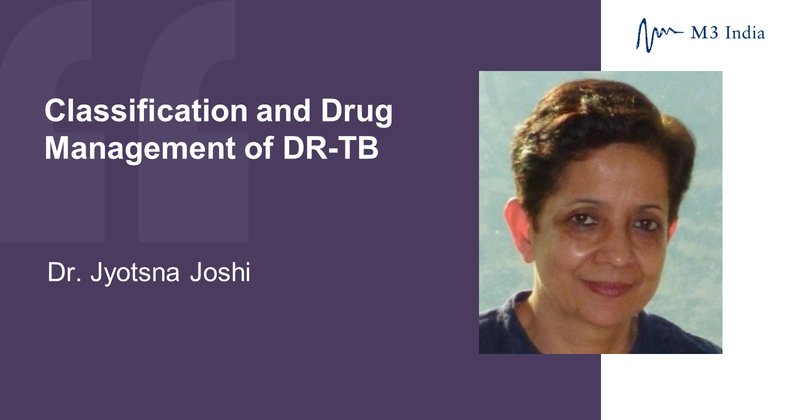Drug Resistant Tuberculosis: Classification and drug management:Dr. Jyotsna Joshi
M3 India Newsdesk Oct 02, 2018
Dr. Jyotsna Joshi, a noted Pulmonologist takes us through the classification and drug management protocol of drug-resistant Tuberculosis.

Tuberculosis (TB) in India contributes to approximately one-fourth of the global burden of the disease. Drug-sensitive TB is treated with short-course chemotherapy with first-line anti-TB drugs like Isoniazid (H), Rifampicin (R), Pyrazinamide (Z), Ethambutol (E) and Streptomycin (S). However, the increasing prevalence of drug resistance TB prevents effective control of the disease.
- Drug-Resistant TB (DR-TB) is further classified as primary or secondary drug resistance depending on the previous exposure to anti TB drugs.
- TB is further classified as Rifampicin Resistant TB (RR-TB) which is an infection with TB bacilli resistant to at least R and Multidrug-Resistant TB (MDR-TB) which is an infection with TB bacilli resistant to both H and R.
- Depending on the further drug susceptibility testing (DST) for second line anti TB drugs, MDR-TB is subclassified as Pre-Extensively Drug-Resistant Tuberculosis (Pre XDR-TB) and Extensively Drug-Resistant Tuberculosis (XDR-TB).
Pre XDR-, XDR-, & XXDR-TB
- Pre XDR-TB is defined as additional resistance to second-line drugs (SLD) either Fluoroquinolone (FQ), or to at least one of the three second-line injectables (SLI) [Amikacin, Kanamycin, and Capreomycin (SLI)]. The former is called as Pre XDR-TB (FQ) while the latter called as Pre XDR-TB (SLI).
- XDR-TB is defined as MDR-TB with additional resistance to both FQ and SLI.
- “Extremely” drug-resistant (XXDR-TB) or total drug-resistant TB (TDR) have been proposed for cases resistant to all available first- and second-line drugs.
DR-TB is predominantly a man-made problem culminating from various factors- microbiological, programmatic, doctor, and patient-related factors. TB can majorly be classified as Pulmonary and extrapulmonary depending on the presence or absence of lung parenchymal involvement.
Extrapulmonary TB (EPTB) is a non-infectious and paucibacillary disease and the affected patients are non-infectious. EPTB accounts for approximately 15% of the total TB burden and includes pleural effusion, lymph node TB, spine TB, bone and joint TB, CNS TB and all other extrapulmonary sites.
However, drug resistance in EPTB is a formidable challenge owing to its heterogeneous presentations and difficulty in sample procurement for microbiological diagnosis leading to a delay in therapy initiation.
Management of DR-TB
The therapy universally available for the management of MDR PTB as well as EPTB is a DST based therapy under the programmatic management of drug-resistant TB (PMDT) guidelines.
Among the second line drugs, however, the World Health Organization (WHO) endorses baseline testing for FQ and SLI only due reliable and standardised in vitro tests. This standpoint is based on the rationale that a baseline DST enables appropriate modification of the therapy at commencement itself and saliently betters the treatment outcomes.
Drug-resistant tuberculosis (DR-TB) is managed as per the Revised National Tuberculosis Control Program (RNTCP) programmatic management of DR-TB (PMDT) guidelines in consensus with the World Health Organization (WHO) DR-TB guidelines.
The RNTCP PMDT guidelines were published in May 2012 following the WHO DR-TB 2011 guidelines. In 2016, a preliminary update of the RNTCP PMDT guidelines was available with the start of conditional access to new drugs (such as bedaquiline). The 2017 revision of RNTCP PMDT guidelines took into account the updated WHO DR-TB 2016 guidelines. The WHO DR-TB 2016 guidelines had reclassified drugs into groups on the evidence of updates in literature.
The encouraging drug trial results for clofazimine and linezolid have resulted in their escalation/prioritisation as Group C “core” second-line drugs. However, the age-old drug, para-aminosalicylic acid (PAS), was demoted and reclassified as Group D3 “add-on” drugs.
More recently, WHO guidelines recommend shorter MDR therapy for pure MDR-TB cases by the exclusion of resistance to FQ and SLI. Gene Xpert is extremely useful for rapid diagnosis of MDR TB. It was developed as a rapid test to diagnose pulmonary TB and to detect rifampicin resistance.
Further testing for SLD is done at baseline by Line Probe Assay (LPA). LPA can be done on sputum smear positive samples or positive culture of samples from Pulmonary and Extrapulmonary sites.
Regimen
- The shorter regimen also called the Bangladesh regimen consists of 4-6 Km-Mfx-Pto-Cfz-Z-Hhigh-dose-E / 5 Mfx-Cfz-Z-E
- If there is resistance to either FQ or SLI standard, longer regimens are to be given with suitable modification. This conventional regimen consists of 8Km-Lfx-Eto-Cs-E-Z+12Lfx-Eto-Cs-E
Km=Kanamycin; Mfx=Moxifloxacin; Lfx= Levofloxacin; Eto=Ethionamide; Pto=Prothionamide; Cs= Cycloserine;
Cfz=Clofazimine; Z=Pyrazinamide; Hhigh-dose= high-dose Isoniazid; E=Ethambutol.
Note: In case of resistance to Km or FQ substitution with other SLDs is recommended.
WHO's key medicine changes for MDR-TB regimen
Recently (2018) WHO has made key medicine changes for the longer MDR-TB regimens. The revised grouping of TB medicines recommended for use in longer MDR-TB regimens is as follows. Medicines have been regrouped into three categories and ranked based on the latest evidence about the balance of effectiveness to safety:
- Group A: Medicines to be prioritised: levofloxacin/moxifloxacin, bedaquiline and linezolid
- Group B: Medicines to be added next: clofazimine, cycloserine/terizidone
- Group C: Medicines to be included to complete the regimens and when agents from Groups A and B cannot be used
- Ethambutol
- Delamanid
- Pyrazinamide
- Imipenem-cilastatin
- Meropenem
- Amikacin (streptomycin)
- Ethionamide/prothionamide
- p-aminosalicylic acid
This recommendation is still to be incorporated in the RNTCP- PMDT.
Disclaimer- The views and opinions expressed in this article are those of the author's and do not necessarily reflect the official policy or position of M3 India.
-
Exclusive Write-ups & Webinars by KOLs
-
Daily Quiz by specialty
-
Paid Market Research Surveys
-
Case discussions, News & Journals' summaries